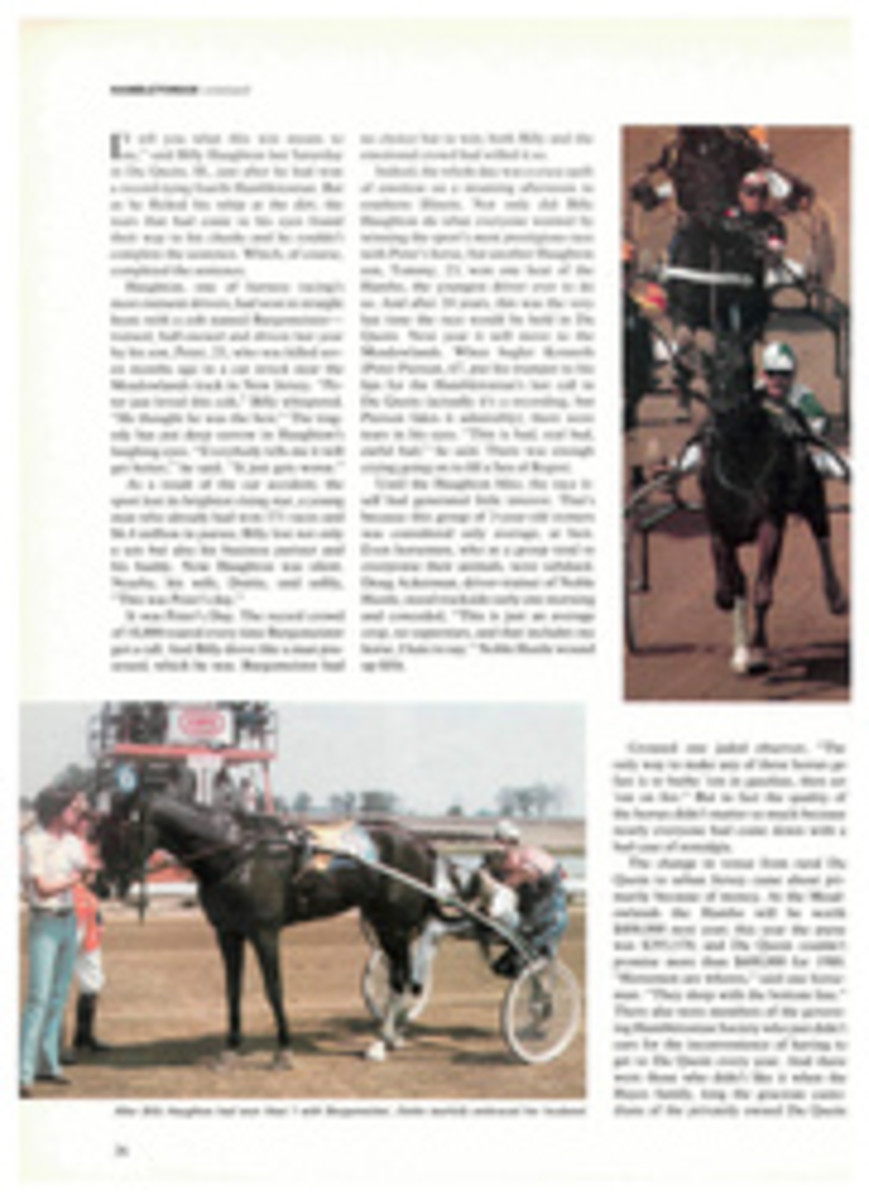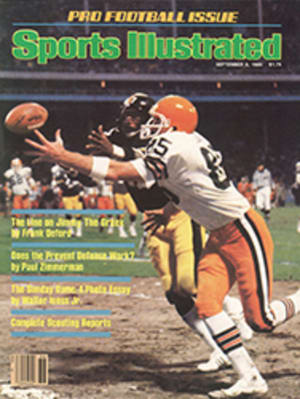
IN THREE-ON-THREE IN ROCKAWAY THE BALL WENT THISAWAY AND THATAWAY
The year is 1948, and it is a hot summer morning on a basketball court in a playground at 108th Street in Rockaway Beach, a part of New York City. One end of the court is deserted. At the other end, watched by 20 or 30 young men who are sitting against the fence awaiting their turn to play and by a large crowd standing on the boardwalk, six youths are playing a game of half-court basketball. Player No. 1 throws the ball in from under the basket and out across the foul line to player No. 2, who dribbles twice to his left as player No. 3 goes to his right behind him, running his man into a pick. No. 2 gives the ball back to No. 1, who throws a bounce pass to No. 3 as he comes down the lane toward the basket. No. 1's man picks up No. 3, who appears to be going in for a layup. Suddenly, with his gaze fixed on the basket. No. 3 flicks the ball to No. 1, who is all alone. With both feet on the ground. No. 1 sends up a high looping shot. The ball, apparently off course, hits a dead place high on the backboard and drops through the hoop. There is no swish because there is no net. Bob Cousy, Al McGuire and Dick McGuire are playing the Rockaway Game, quite possibly the most sophisticated street or playground game ever played in the city of New York. There are no slam-dunks, no midair 360-degree spins, no jump shots, but the game is far from dull. Although the players don't have the physical attributes of today's athletes, they have a style, a finesse, an aggressiveness, especially on defense, and, above all, a sense of teamwork that in recent years has all but vanished from both playgrounds and the pro game.
It began in 1939 when the playground, later known unofficially as "McGuire's playground," was built and the baskets were installed. The local kids came out, and under the leadership of 13-year-old Dick McGuire, whose parents owned a bar a block away, began to develop their own special, unselfish brand of play, a style rooted partly in the Irish-Catholic ethos, in which self-effacement plays a large role, and partly in the reverse snobbery of old-fashioned New York cool. There were no "all-worlds" or "I am the greatests" at Rockaway. If you ask Dick McGuire, for eight years the New York Knickerbockers' playmaking guard and now their chief scout, how he developed the passing game that made him famous, he says, "We had to pass a lot because we weren't as good as the players today. They don't need to do what we did. They bring the ball up with one hand and shoot a 20-foot jumper right in your face. We had to look for the open man."
At first the game belonged to the permanent residents of Rockaway—Dick McGuire; brother Al, who became famous in the NBA for saying that he "owned" Bob Cousy; brother John, known for his football-style defensive tactics; occasionally Gil Clancy, now director of boxing for Madison Square Garden; Harry Day, who knew the dead spots on the backboard better than anyone; and even a few non-Irish—for example, Norman Ochs, Buddy Ackerman and Ed Bacalles, the last famed for his ability to shoot accurately in a high wind. "I was Jewish, but I knew what mass every kid who owned a ball went to," says Ochs. "I'd get to Jackie Craven's house 15 minutes before mass and I'd say, 'Hey, let's play basketball.' He'd say, 'I don't know, I have to go to mass.' 'Well, look,' I'd say, 'give me the ball and we'll get you into a game right after mass.' Then when he'd get there, there'd be 25 or 30 guys ahead of him."
One way or the other, they played. If the bladder of a ball broke, they'd fill it with newspaper and forget about dribbling. If there was no ball at all, they'd roll up a few woolen watch caps. Passing became the name of the game, and the disease known as "Rockawayitis," or one pass too many, came into being. Gradually the word spread and players started to come from outside Rocka-way—Jimmy Weston, now the owner of a restaurant in the East 50s, from Ridge-wood, Queens; Bobby Wanzer and Sherman White from New Jersey; Carl Braun from Garden City; Ray Lumpp from Forest Hills; Richie Guerin and Dolph Schayes from the Bronx; Chuck Connors, of The Rifleman fame, from Brooklyn; Ray Felix from Manhattan; Tommy Heinsohn from way over in Union City, N.J.; and from St. Albans, another part of Queens, one Robert Cousy. "We didn't know it then, but we were laying the foundations of the modern NBA," says Al McGuire. "It was the top guns coming in from everywhere."
But Cousy, Heinsohn and Schayes notwithstanding, the playground belonged to Dick McGuire. Often he would come over barefoot and say, "I'm not playing today." Then someone would say, "Get Dick a pair of sneakers." One day he'd play in a size 9 and another day in a 10½ Sometimes he played barefoot, and on one occasion he destroyed a group of hot-shots from Andrew Jackson High while wearing a blue suit and leather-soled shoes. It didn't matter to him who was on his side. It could be a 15-year-old, it could be Dolph Schayes. Dick McGuire made everybody look good, and when something went wrong it was always "My mistake, my mistake."
McGuire and his Rockaway buddies played through the '50s, getting more and more sophisticated, but the game petered out in the mid-'60s when urban renewal brought an end to the Rockaway way of life. "It was the place the pros came to in the summer to sharpen their skills," says Lumpp, a former Knick and now athletic director at the New York Athletic Club. "It was a rough, physical game, but there were no fights. You called your own fouls, and sometimes you even called them on yourself. Defense was tough because the team that scored kept the ball. If you didn't play defense you could be off the court in no time. And you stuck to the basics—weave, pick and roll, give and go, look for the open man, one hand up on defense, one hand down, no cross-court passes, when you get a rebound don't bring the ball down or they'll take it away. Above all, move without the ball. Today they break every one of these rules. They're so good they don't have to follow the basics." This is said without a trace of sarcasm. Humility was and is the Rockaway code.
Maybe they are that good, and maybe it's worth paying $13.50 to watch four guys stand around while one grabs a rebound, jogs down the court and throws up an off-balance 30-footer, but not according to Cousy. "They're bigger and stronger than we were," he says. "They jump higher and shoot better but with respect to the other skills, they've regressed. You have to create movement. The way we played is still the right way."
It's pretty hard to argue with Cousy, because NBA championships usually are still won by the teams that pay at least some attention to the basics—teams like Washington, Portland and Seattle. No matter how fantastic an individual's abilities are, it's still the open man who has the best chance of scoring, not the hotshot who yells "in your face." For those teams that keep asking why they have losing records despite being loaded with $500,000 "superstars," the answer is simple: move your training camp to Rockaway. The air is clean and the hotel rates are cheap. Harry Day is dead now and Al McGuire is in Milwaukee, but Ed Bacalles and John McGuire are still around, Braun, Lumpp and Ochs aren't far away, Gil Clancy still comes down to body-surf, and Dick—well, if somebody can just find him a pair of sneakers, maybe he can demonstrate how to hit the open man.
ILLUSTRATION

